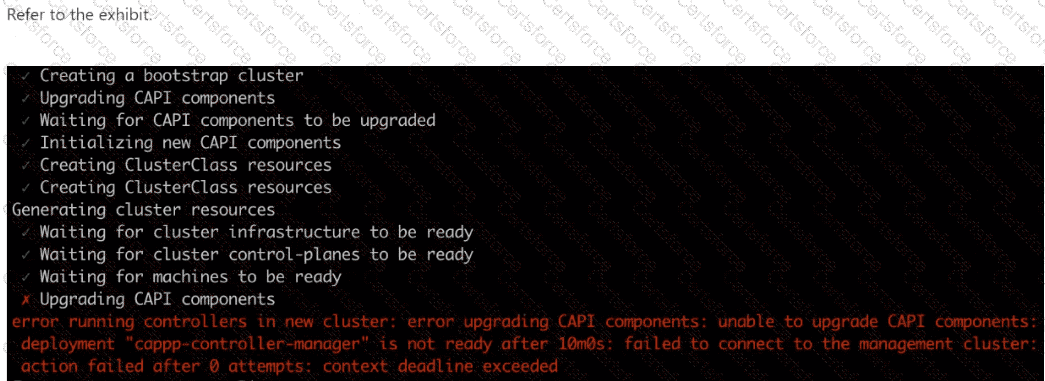
An administrator is provisioning an NKP cluster. After the VM creation task, the error shown in the exhibit is produced.
What could be the reason?
A company uses an Artifactory private registry for development. The NKP deployment must use this private registry since the Security Administrator has the firewall configured to reject connections to public container registries. The first task is to push the NKP bundle to this private registry.
What options should be used to push the NKP bundle to this private registry?
A Platform Engineer is getting started with NKP and has created a bastion host with all needed prerequisites.
How should the engineer install Kommander?
When deploying an NKP cluster onto air-gapped, pre-provisioned servers, Konvoy Image Builder is utilized to prepare the servers to become NKP cluster nodes.
What does the konvoy-image upload command do as a part of this preparation process?
A company has 30 Edge devices with lightweight Kubernetes, and developers need to push the application to every edge device. An NKP administrator has the NKP Ultimate license tier configured and has access to all kubeconfig files for the 30 edge devices. What is the most efficient way that the administrator can lifecycle manage the application deployments?
Which NKP-supported infrastructure will not receive CAPI components when an NKP cluster is deployed to it?
A company has decided to expand NKP to features that require higher product tiers, like fleet-management and additional infrastructure providers. The company has already obtained the necessary licensing. Which action is required when adding and activating a license from NKP Starter to a higher-tier product?
A company has different Kubernetes clusters for different business units. Every business unit has separate Kubernetes clusters for production and development because the software deployed in production is different than development. Now, all production clusters for all business units are standardized and all clusters for development are standardized as well.
The company recently acquired NKP Ultimate licenses for all Kubernetes clusters.
How can the company control the standard configuration for both environments in all clusters (production and development)?
Using an NKP Ultimate license, a Platform Engineer has created a new workspace and needs to create a new Kubernetes cluster within this workspace. However, the engineer discovers that the Create Cluster option is grayed out, as shown in the exhibit. How should the engineer resolve this issue?
A Kubernetes administrator needs to ensure that the following requirements are met whenever a new workload cluster is deployed to a workspace:
Grafana Logging
Grafana Loki
Project LoggingHow would the administrator ensure that these components are deployed as part of a cluster deployment?